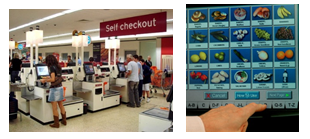Lean and Business Management Consultant, Mountain Ridge Consulting, https://www.linkedin.com/in/edwardgemin
Shopping is one of the best places to see lean concepts at work. This is because a large portion of the foundation of lean was taken from American supermarkets. When Taiichi Ohno, father of the Toyota Production System, visited an American supermarket in 1965, he saw how he wanted his factories to look and operate.
 The American supermarket is the birthplace of Just in Time and is a prime illustration of Ohno’s vision of a lean factory: clean and organized with visual controls to navigate shoppers seamlessly to the product that they want to purchase, while enticing shoppers to buy what they are looking for and even what they are not. The inventory system may be seen in designs such as flow racks, where milk slides down by the ”First-In, First-Out” method of delivery.
The American supermarket is the birthplace of Just in Time and is a prime illustration of Ohno’s vision of a lean factory: clean and organized with visual controls to navigate shoppers seamlessly to the product that they want to purchase, while enticing shoppers to buy what they are looking for and even what they are not. The inventory system may be seen in designs such as flow racks, where milk slides down by the ”First-In, First-Out” method of delivery.
Inventory systems are managed with extreme care in supermarkets to ensure that the right amount of product is on hand and to avoid having too much product and losing it to spoilage. This fight to keep inventory moving before the expiration date forces supermarkets to look at their inventory more meticulously than many factories and creates an efficient system to manage this inventory.
 Self-checkout is another great example of lean at work. Self-checkout has made purchasing so easy that many people prefer this quicker process. Think about it, supermarkets have streamlined the self-checkout process to the point where customers prefer to perform a task themselves that the supermarket was once required to pay several employees to perform. Supermarkets would never have been able to do this if the self-checkout process was difficult. If years of experience or a big product code book were required to find the product code for bananas, people would visit the regular checkout stand instead. Now via a visual system customers may browse pictures of the product that they wish to buy with an easy two to three taps on a screen.
Self-checkout is another great example of lean at work. Self-checkout has made purchasing so easy that many people prefer this quicker process. Think about it, supermarkets have streamlined the self-checkout process to the point where customers prefer to perform a task themselves that the supermarket was once required to pay several employees to perform. Supermarkets would never have been able to do this if the self-checkout process was difficult. If years of experience or a big product code book were required to find the product code for bananas, people would visit the regular checkout stand instead. Now via a visual system customers may browse pictures of the product that they wish to buy with an easy two to three taps on a screen.
Andon lights, line stoppages, and error proofing are other lean concepts represented in the self-checkout lane and are a perfect example of autonomation. Andon lights notify employee managing the self-checkout area that the customer needs help or when a machine isn’t working correctly. These machines also have error-proofing and line stoppage in place. If a customer is trying to purchase an adult beverage, the machine stops the purchase and notifies the employee and then can require the employee to verify and enter the customer’s birthdate into the machine -- an easy, consistent, and accurate way of tracking and verifying the sale. The machine even cross checks the weight of the objects placed on the scale with the system to determine the correct item was also placed in the bagging area after it was scanned.
Milk racks, visual controls and self-checkout stations are examples of what the customer may see from the floor. What is really impressive is the amazing inventory and logistics system operating behind the scenes. This system tracks all sales and helps insure that only what has been sold is re-ordered.
Have fun shopping, and keep an eye out for the lean world around you.


